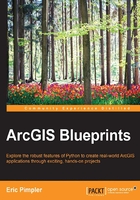
Conventions
In this book, you will find a number of text styles that distinguish between different kinds of information. Here are some examples of these styles and an explanation of their meaning.
Code words in text, database table names, folder names, filenames, file extensions, pathnames, dummy URLs, user input, and Twitter handles are shown as follows: "The ArcPy data access module that is arcpy.da."
A block of code is set as follows:
def getParameterInfo(self):
"""Define parameter definitions"""
param0 = arcpy.Parameter(displayName = "ArcGIS Server Wildfire URL", \
name="url", \
datatype="GPString", \
parameterType="Required",\
direction="Input")
When we wish to draw your attention to a particular part of a code block, the relevant lines or items are set in bold:
parameterType="Required",\
direction="Input")
params = [param0, param1]
return params
Any command-line input or output is written as follows:
# cp /usr/src/asterisk-addons/configs/cdr_mysql.conf.sample /etc/asterisk/cdr_mysql.conf
New terms and important words are shown in bold. Words that you see on the screen, for example, in menus or dialog boxes, appear in the text like this: "You can create a Python Toolbox in a folder by right-clicking on the Folder and navigating to New | Python Toolbox."
Note
Warnings or important notes appear in a box like this.
Tip
Tips and tricks appear like this.